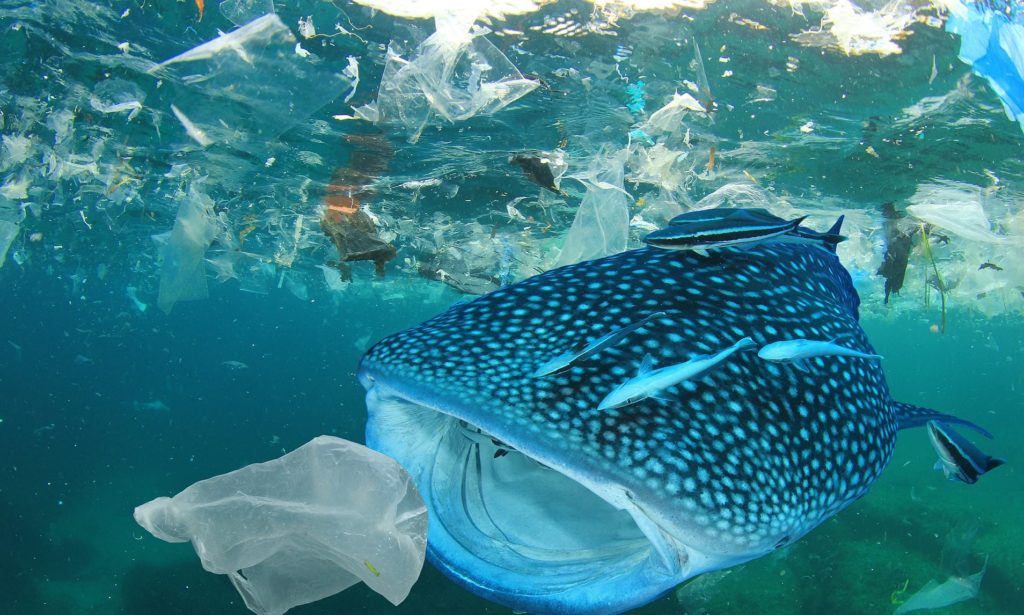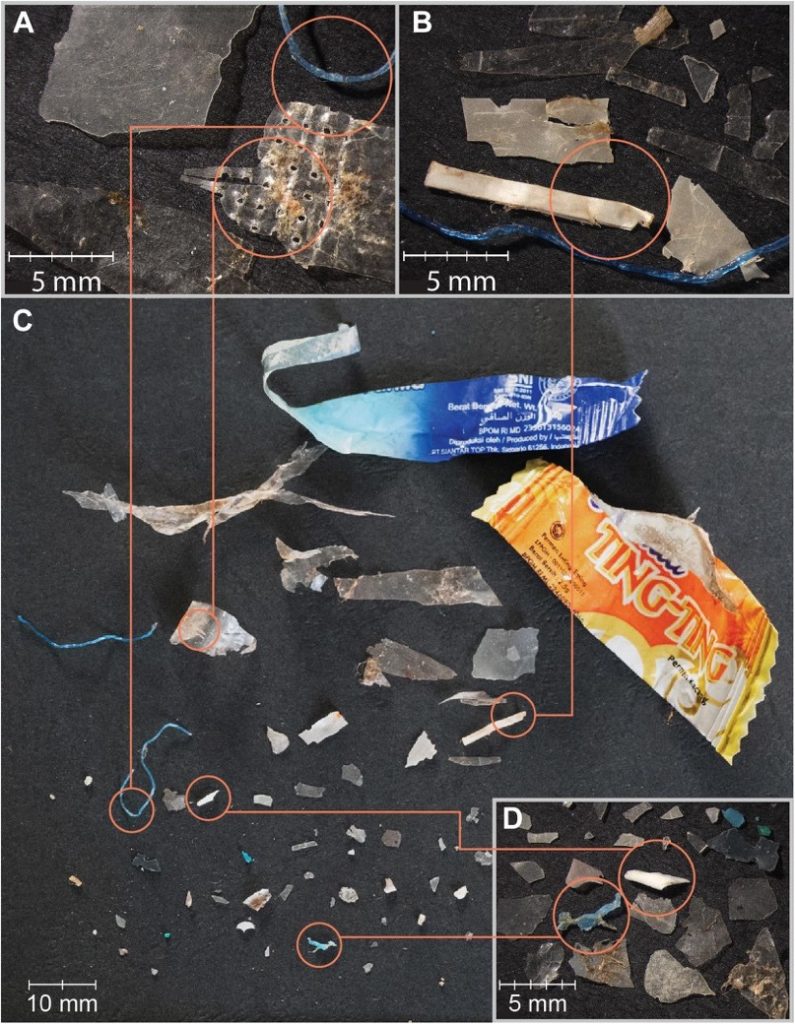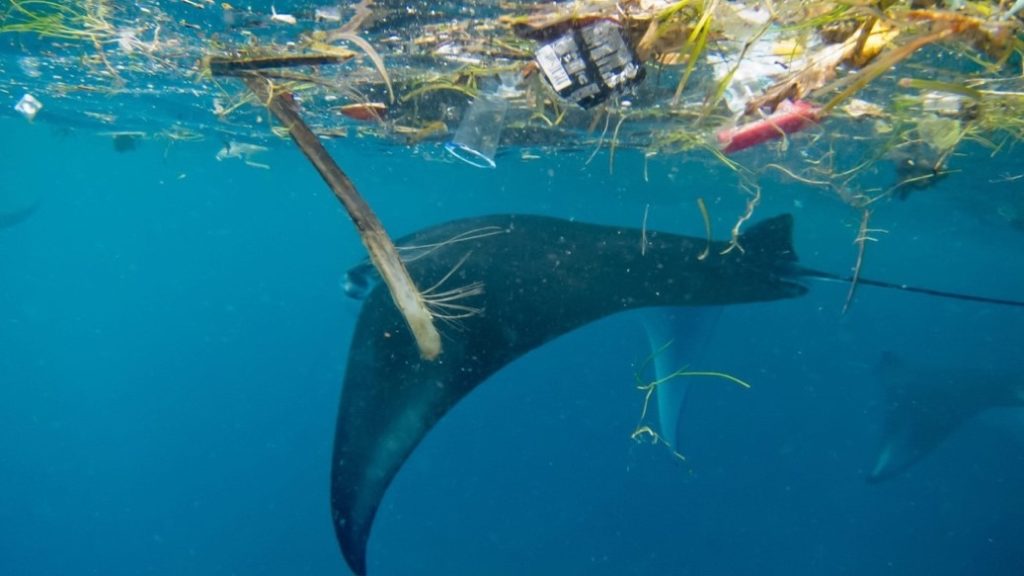Plastic, it is impossible to escape. Almost every single activity you have undertaken today will have included some sort of plastic. Your toothbrush, phone case, food containers, even your car. Every single year trillions of new items of plastic debris enter the ocean. The extent of damage is extreme and devastating, even to marine megafauna. The article ‘Microplastics on the Menu: Plastics Pollute Indonesian Manta Ray and Whale Shark Feeding Grounds’ written by Germanov et al. (2019) (1) highlights the extent of the microplastic problem within the ocean, and the impact on whale sharks and manta rays.

Figure 1. A whale shark accidentally mistaking a plastic bag for a jellyfish while feeding (2)
How Could Such Tiny Plastics Hurt Such Large Creatures?
Whale sharks and manta rays are beautiful giants of the ocean with long life spans. Both are filter feeders, feeding in a variety of habitats where marine litter often accumulates (1). They use their large mouths to suck in water, filtering planktonic organisms such as krill through their gill plates. As such, they are highly susceptible to uptake of microplastics that are filtered from the water column along with their food, or acquired indirectly through zooplankton that have also ingested microplastics (1). The direct effects of ingesting foreign objects, may be compounded by the fact that plastics are known to adsorb toxic chemicals, some of which lead to bioaccumulation over an organism’s life-time, and maternal off-loading to young.
Research program
The research took place in the sea of south-central Indonesia between 2016-2018. Samples were taken by dragging a fine mesh net through the water imitating the way whale sharks and rays would feed themselves. Based on the amount of plastic debris that was collected, researches were able to calculate the amount of plastic a manta ray or whale shark would ingest (1). Indonesia, the feeding ground for these animals is ranked the second worst plastic polluter in the world (1). The study found that plastic during the rainy season was 44 times higher than the dry season, therefore the ingestion rate varied by season (1). The upper level plastic ingestion rates for manta rays was 63 pieces per hour, and 137 pieces per hour for whale sharks (1). These shocking statistics underscore the devastating impacts plastic pollution is having on marine life. Constant exposure to toxic plastic has severe short- and long-term effect for both of manta rays and whale sharks.
“an estimate of 63 pieces of plastic per hour is ingested by manta rays, whilst around 137 pieces per hour are ingested by whale sharks”
The research team also investigated manta rays faeces and vomit. Measurements in these samples varied significantly with one faecal sample having 26 plastic pieces and a vomit sample with 66 pieces. (1). These observations confirm that manta rays and whale sharks are ingesting plastics (1).
Various types of plastics are consumed by both manta rays and whale sharks. Once the plastic begins to break down, they will reach sizes so minute that they are not visible to the naked eye (nanoplastics)(figure 2) (1) Approximately 80% of the plastics measured in this study were less than 5mm (1), emphasising how easily these microplastics can be ingested alongside prey.

Manta rays and whale sharks have to feed in high density prey patches to be able to reach a positive energy balance, as their feeding behaviours are energetically costly (1). The research conducted is likely to underestimate plastic intake as plastic abundance estimates were limited to free-floating plastics, and did not include any plastic ingested by zooplankton prey. If feeding in a polluted area for many hours each day, the manta rays and whale sharks could potentially be ingesting huge amounts of plastic (1). Further, this study has only covered one known feeding ground. Plastic abundance has not been assessed elsewhere. yet feeding occurs in many regions at many different depths, therefore the total potential plastic intake is still unknown.
Implications of Plastic Ingestion
Both manta rays and whale sharks are threatened species, any changes in their reproductive rates or population number could be very detrimental. Endocrine disrupting chemicals have been associated with plastics, and these have the potential to interfere with hormones that regulate the animals metabolism, growth, development and reproductive functions (1). Large plastic particles that may be ingested can also block nutrient absorption and damage the digestive tract (1). In the past a beached whale shark has been found with internal perforations from a single hardened plastic straw, causing death (1).

“both manta rays and whale sharks are threatened species”
Preventing Plastic Pollution
Plastic pollution is one of the largest environmental challenges society has faced to date. Within Indonesia where this study took place, the government pledged 1 billion (USD) towards reducing marine plastic debris by 70% before 2025 (1). Recently bans have been placed on single use plastics in many cities in Indonesia, and all over the world. Unfortunately, plastic pollution has already had a significant impact on the whole marine ecosystem. For hundreds of years to come plastic will continuously be ingested by all marine animals, including whale sharks and manta rays.
Continuing to monitor these coastal environments to further our understanding of how local oceanography contributes to the accumulation of plastic debris will be an important component in curbing this threat (1).
There are many individual actions that you can take to help mitigate marine plastic pollution. Simple things such as
refusing single use plastics whenever you can; buying reusable items such as keep-cups or water bottles; reducing
your single use plastics at home; shopping at local markets will help reduce new pollution. Similarly, if you see waste on the beach – pick it up, and educate others on this issue. The more people aware, the greater the positive change will be!




Recent Comments